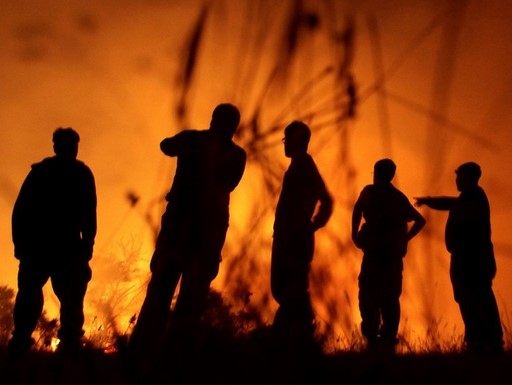Record-setting temperatures and lack of rain helped to fuel a devastating year of wildfires in Chile — and researchers say more is on the way due to climate change and poor land-use management.
By Eva Hershaw
After months of record high temperatures and prolonged drought, cool air and rain have returned to central Chile, marking the likely end of a historic wildfire season that killed at least 11 people, destroyed more than 1,600 homes and charred more than 1.4 million acres.
Drone footage released by the BBC and satellite images from NASA’s Earth Observatory show burnt homes among white, ash-covered soil and a nearly 15-mile-long burn patch through a bright green forest. Some 7,370 people across six states were impacted by the blazes, according to the Chilean National Forest Corporation.
CONAF reported Monday that firefighters had extinguished or brought under control 50 of the country’s 56 ongoing fires.
President Michelle Bachelet has called for the country to begin reconstruction of devastated areas.
But as the country begins to survey the damage and erect temporary housing, forestry experts and climate scientists warn that the country must also prepare for a warmer and drier future that could render Chile vulnerable to more frequent, more intense extreme fire events.
CONAF reported that nearly 1.5 million acres have been consumed by wildfires since July — an area nearly 13 times the historical average for a single fire season.
Record shattering temperatures are helping to fuel the blazes. Temperatures for the month of January were 6.1 degrees Fahrenheit above the previous record and the mercury hit 113F in Cauquenes late in the month.
In the O’Higgins region, which lost nearly 150,000 acres of native and planted forest in recent weeks, local CONAF forest engineer Felipe Sandoval said the scale and damage done by the recent fires was unprecedented, though he has seen signals that the climate is changing for many years.
«The impact of climate change here is absolute,» Sandoval said. «In the 1980s and 1990s, the region received an average of 600 milliliters of water annually — for the last eight years, we have received just around half, at 300ml.»
Juan Boisier, a climate scientist at the University of Chile, said the lack of rain is part of the «Southeast Pacific drying,» a phenomenon that stands out as a clear example of extreme precipitation decline. In a study published last year, Boisier and several colleagues found that approximately half of the precipitation decline observed in Chile is due to natural climate variability, while the remaining portion is brought about by anthropogenic climate change.
Roberto Rondanelli, a professor of geophysics at the University of Chile who worked with Boisier on the study, said their research points the way toward better preparation for future wildfires. «All of the models show a warming in the central region of Chile, the region where the fires are currently,» said Rondanelli. «In some way, we were warned of what could happen and are now seeing it take place.»
This persistent lack of rainfall that contributes to multi-year megadroughts in Chile has had the effect of extending the forest fire season across the country and other parts of South America. Similar patterns can also be seen in Peru, to the north of Chile, where ongoing drought recently gave way to downpours that killed at least 20 people, including six miners that were buried in a landslide. Just a few months prior, the country declared a state of emergency as it was ravaged by forest fires.
Researchers predict an increase in extreme wildfires in Australia, the Mediterranean and in the sub-tropical Southern Hemisphere. Analyzing data on 23 million fires that occurred between 2002 and 2013, David Bowman of the University of Tazmania said to expect a 20 to 50 percent increase in the number of days conducive to wildfire events.
Another study, published last year by scientists from Spain and Chile, found that the fire regime — the frequency, intensity, and pattern of blazes — had grown at an «alarming rate.» While the authors point to the influence of climate change, their research suggests human changes to the landscape are also increasing fire activity. The number of fire incidents, they found, had increased most drastically along the interface between forest areas and expanding urban zones — such as around the cities of Valparaíso and Santiago. They also noted a higher incidence of fire activity in commercial forest plantations common in the Araucanía and Bio-Bio regions.
Fifty-nine percent of land lost this year to wildfires was forests allocated for agricultural production, according to CONAF, while natural forest and brush accounted for only 25 percent.
While he doesn’t believe that forest plantations burn at a faster rate, CONAF’s Sandoval is certain that native forests provide environmental services that make the landscape more resilient. Last week he was worried about rapidly spreading wildfires, but this week his concern has turned to impending rains.
«They’ll run across the bare land and cause further erosion,» he said. «Without trees in the ground, the rains that will come soon are going to be lost, and any regrowth we can expect will be in bad shape.»
Leer en Seeker.com

